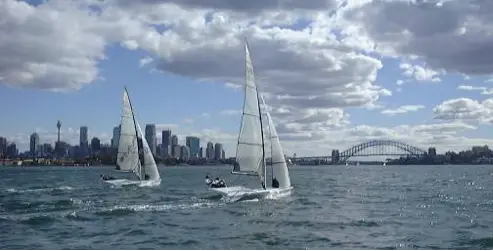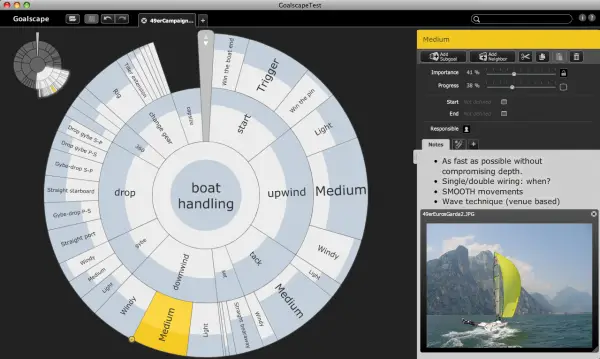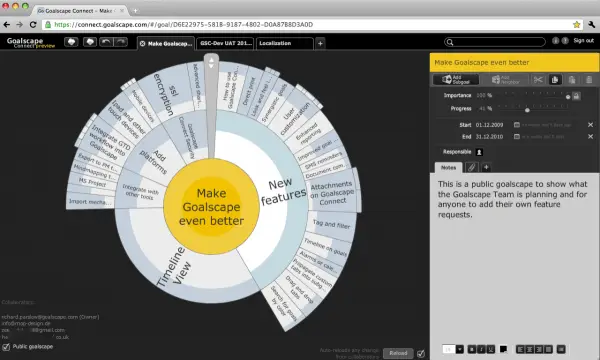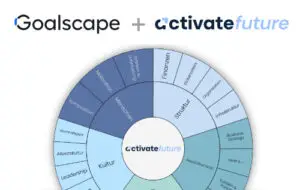As a professional sailor I desperately wanted compete at the Sydney 2000 Olympics. I had already done quite well and had won a few national regattas; but had not had much success at top level. The Olympics is a serious challenge and I was no likely candidate. But I just loved sailing the exciting new boat that had been chosen for the next Games; and I was fanatically determined to sail against the world’s best sailors on one of the most beautiful stretches of water anywhere: Sydney Harbor. So I set out on the journey with my sailing partner, neither of us having any idea what a roller-coaster ride it would be.

The challenge before us was complex. The 49er was a new class of boat that hardly anybody could handle and we had very little experience to build upon. We also knew we would have to take our racing skills and our physical fitness to completely new levels, as well as learning to sail the boat. And on top of all that we had organize everything ourselves and raise the money for what to many seemed like a 4-year holiday. Of course the reality was a lot of hard work with long days and plenty of ups and downs. It was intense, but very rewarding because we were really focused on our shared dream goal – and we loved to sail the boat for hours at a time, day after day.
We had incredibly long to-do lists, so it was frustrating and stressful trying to fit in everything we had to do each day. I knew that if we were to reach our goal, we had to approach this challenge in a better way. Setting the right priorities is easier said then done when entering uncharted territory: there always seemed too much to do and resources were scarce. But the clock was ticking, so we had to prioritize if we were to achieve anything at all.
What I needed was a visual map to show the entire structure of the challenge: every goal and subgoal. I wanted to fly over the landscape of goals and get the view from 30,000 feet: seeing all the goals at once and the connections between them. What’s more I had to track our progress in every area so I could always see exactly where we were in order to decide what to do next.
So I came up with the Goalscape goal map. A multi-level pie chart seemed to be the best way to break down the huge challenge into specific goals and subgoals in every area. The circle represented the fact that our resources were limited: when we spent time, money and energy in one area, we could not spend it anywhere else.
My first goalscape chart covered only the boathandling area, a specific part of sailing that is particularly important in the 49er class.

The boat is so difficult to sail that many international champions from other classes spent most of their time upside-down – and quite a few of them quit. My goalscape displayed ALL the maneuvers we needed to perform during a race. On the goal map we gave the most important maneuvers (those that contributed most to our success on the racecourse) the biggest slices.
For each maneuver the goal was to perform it automatically without thinking about it, so that we had all our brain capacity available for strategic and tactical decisions. And on each goal we marked our progress by filling in its slice, so we could literally see our skills improving all the time.
We soon realized that this system could also be used very effectively in other areas like fitness, gear testing and tuning for speed, or planning our logistics and financials.
Actually being able to SEE the challenge like this certainly helped us to be better organized and to improve faster in our sailing: we climbed to the top of the world rankings and qualified to represent our country at the Olympic games. So we achieved our first major goal!
As we progressed through our campaign, we had been re-evaluating our goals: changing the relative importance of each to match the requirements of the next phase. By the time we arrived in Sydney we were set on winning a medal.

In fact we led the Olympic regatta until the 6th race, when we started to succumb to one of our weaknesses (I am not going to say what that was!). In the end we finished 5th, which was respectable – but it was not what we had aimed for. Even in defeat though, Goalscape helped a lot when we analyzed what went wrong. It clarified how under the prevailing conditions one weakness had led to another.
After that experience I was certain that the Goalscape concept needed a computer implementation to achieve its full potential. Drawing goalscapes by hand was slow and tedious: it could not deal with the evolving challenge and its rapidly shifting priorities. And I already had lots of detailed information in different formats (like notes and diaries, spreadsheets, even video files) that I needed to access for different goals. So the idea of Goalscape as a visual software tool grew in my mind. Soon I was just as determined to create it, as I had been keen to master the 49er. Fortunately I was able to assemble a great international team to join me on the project.
Designing a solid, useful, simple and beautiful piece of software proved to be as challenging as competing at the Olympics. After a lot of hard work (and a couple of false starts!) we launched our first public version of Goalscape in late 2009. Today it’s a complete, mature visualization solution: this is what the boat handling breakdown looks like now:


I just wish I had had this back in 1997 when I first set out on my Olympic quest!
Goalscape’s real power lies in its unique ability to display in a single image the key success factors of any challenge:
- Specific, inspirational goals
- Clear relative priorities
- Continual evaluation of progress
Its unique visual, prioritized work breakdown, together with the facility to collect detailed information about every goal, means that Goalscape is perfect for understanding, presenting and managing any challenge. And because it’s dead easy to use, it never gets in the way of the “real work”.
All top sportsmen and coaches (and many progressive businessmen) now use a structured, goal-oriented approach. They know that goals are essential for motivation, commitment and focus; and that shared goals produce cohesive teams with a common purpose.
Goalscape provides a single clear picture of the entire goal structure. So it not only helps leaders to define goals and plans, it is also the ideal way to communicate those goals and plans to everyone involved, then track progress and agree any changes required as circumstances change.

Unlike other, less structured, visual tools, Goalscape is not just for brainstorming. Users can still “jot down” their high level goals and work out the subgoals needed to achieve them; but then they can set their priorities and allocate resources, building a complete project plan, down to the finest details.
The application has already spread rapidly in the sports community and is being adopted by some very large companies. One of its major benefits to such organizations is that they can take a standard model and adapt it to suit specific requirements.
Similarly, corporations (and consultants) can take a standard industry, business or project model, adapt it to suit different goals and situations, then make detailed plans (with roles, responsibilities and timescales). They can take it to any level of detail, including agreeing specific goals for every person in the company, which then form the basis for staff reviews.

Goalscape clearly shows when the quality of the goal in the center is underdeveloped, incomplete or badly expressed. Most successful sportsmen are exceptionally highly motivated. They have a clear goal, which is at the center of their attention all the time. In business, average motivation levels are much lower. The main reason for this is a lack of alignment of personal and business goals or the complete absence of a clear, well-communicated visionary goal.
Goalscape is a great way to establish and maintain a proper dialog about goals within an organization. It supports full communication, top down and bottom up, so everyone can understand, adopt and influence the development of corporate goals and strategies.
With our new web version Goalscape Connect (currently available in preview), it becomes an unbeatable tool for fast, agile online collaboration.

Best of all everyone can be more focused and productive at work and at play – and have more fun!



